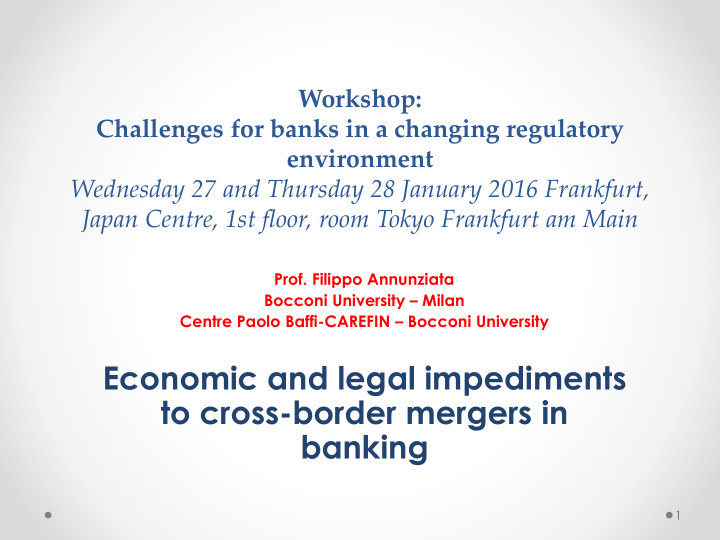



Workshop: Challenges for banks in a changing regulatory environment Wednesday 27 and Thursday 28 January 2016 Frankfurt, Japan Centre, 1st floor, room Tokyo Frankfurt am Main Prof. Filippo Annunziata Bocconi University – Milan Centre Paolo Baffi-CAREFIN – Bocconi University Economic and legal impediments to cross-border mergers in banking 1
• Also due to the aftermaths of the Financial Crisis, cross-border M&As and Mergers amongst financial institutions in the EU have slowed down in the past years. • There are also few updated comprehensive papers or studies in the EU context, in particular as far as the banking or financial sectors 2
• Regardless of recent statystics or numbers, the main factors that are traditionally set out as being potential obstacles for cross border M&As between banks do not seem to havechanged significantly – [since, e.g. Berger and others (2000)] 3
• Main barrier: differences in regulation • In Financial markets, many rules have yet to be written, even if the Single Rulebook and SSM are a significant step forward. The system is however still very recent. • One should not look just as the banking sector, but also at the wider capital markets context (CMU is a good step forward, but the road is long and winding) 4
Wider regulatory barriers, such as different legal and tax • systems, may prevent the full exploitation of any potential gains associated with cross-border bank servicing. Key areas: • Taxation • Judicial procedures • Bankruptcy regulation • Consumer protection • Labour law and employment • Sanctions (nature; judicial review; criminal law) • 5
• Pending investigations and reviews by regulators still represent a burden 6
• Recently, private equity investors have sparkled up the interest in banking M&A, but the trend needs to be better understood. It raises new regulatory questions that may still need to be addressed (i.e. role of the PE investor; governance; leverage) 7
• Banks may not be incentivized to grow past certain asset parameters. The fear is that of being caught by more stringent regulations if a certain size is overcome. The SSM may represent an advantage but also an obstacle to M&A transactions 8
• Efficiency barriers to the cross-border consolidation of financial services in Europe including distance, differences in language, culture, regulatory/supervisory structures, and explicit or implicit rules against foreign competitors. • If these barriers offset most of the potential efficiency gains, they may constitute effective economic obstacles to cross-border consolidation (Berger 2000) 9
• Some Authors - Buch and DeLong (2001) - explained the relative absence of international cross-border bank consolidation by regulatory barriers and information costs related to distance and cultural factors. Are these findings still true? 10
• Finally, a number of theoretical papers have explored the influence of asymmetric information on the structure of bank markets . Dell’Ariccia (2001), e.g., showed that the existence of informational asymmetries may limit the number of banks in a given market and may lead to blockaded entry in some cases. In the process of lending, incumbent banks gather proprietary information about their clients, acquiring an advantage over potential entrants. 11
• Conclusions: - Most findings seem still to be true - Progresses have been made in the field of regulatory convergence (the most evident of which is the SSM and the Single Rulebook) but this is just a side of the matter. - More regulatory convergence is needed but it may not be enough. For some instances it may even work as a deterrent, if it implies a change in the bank’s status and supervision. 12
Recommend
More recommend